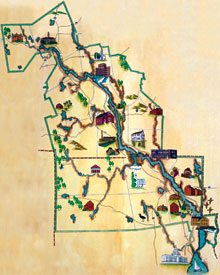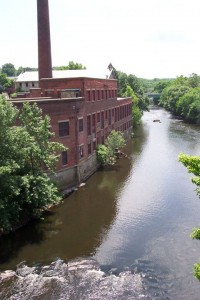
The Blackstone River Valley has always been a hotbed of innovation from its earliest industrialization to experimentation in protected area management with the creation of the national heritage corridor in 1986. Recently, the conservation possibilities of the region have been re-imagined yet again. In 2014, Congress authorized the Blackstone River Valley National Historical Park with a dual purpose to preserve, protect and interpret the industrial heritage as well as its urban, rural and agricultural landscape that provides the overarching context for the region.
Along with individual industrial sites, the park boundaries include the Blackstone Canal and the Blackstone River and its tributaries. The legislation also recognizes the role of the Blackstone River Valley National Heritage Corridor (BRVNHC), which was re-authorized to the year 2021. And to top it off the park legislation permits the National Park Service (NPS) to work outside of the park’s boundaries and enter into agreements with the BRVNHC. This offers an unprecedented opportunity for the NPS to conserve the Blackstone Valley on the landscape level – a living laboratory for NPS’s signature Scaling Up Initiative.
There is also a pressing need for the new park unit and the corridor to work closely together. The proposed 2016 NPS budget, known as the Greenbook, moved $650,00 in funding for the BRVNHC out of the National Heritage Area category and reassigned it to the agency’s operations budget for the new Blackstone River Valley NHP. So is this bad news for the corridor? Not according to Charlene Cutler, corridor’s Executive Director “In broad-brush, the plan for 2016 is for the heritage corridor to develop a cooperative funding agreement with the new park. The corridor will work within the larger landscape on projects that are outside the scope of the national historical park such as community planning, economic development, tourism and education/interpretation about the environment and watershed, as well as historic preservation. This work will be mutually beneficial to the region and to the new national park.”
This is smart thinking, as a former NPS director George Hartzog said “Policy without money is just talk.” At the same time, there are some real concerns that this action diverts scarce dollars from the National Heritage Areas (NHA) program. The 2016 Greenbook already proposes to cut the NHA funding in half from the 2015 appropriation and the $650,000 for the Blackstone Valley would be deducted from that limited pot. It also brushes aside the NHA funding formula that has been painstakingly negotiated over the past several years. Finally, what if park units continue to dip into the NHA funding? Seems a bit unfair considering the NPS overall budget is approaching three billion and the proposal for the NHAs in 2016 is under $10 million.

On the other hand, some veteran national park observers think that this allocation could be an exciting opportunity to jump-start the planning process for the new park. Unlike many newly created parks that languish for years with no capacity and no money, this park in the Blackstone Valley would have a huge advantage. It would have some dollars and just as important a built-in partnership with BRVNHC, an organization with thirty years of successful community engagement and service delivery. What a great opportunity to take advantage of the wholeness of the valley. Charlene Cutler, for one, is optimistic that this is a win-win for the NHAs along with the parks. “Perhaps national heritage area funding would become less volatile if it was coordinated through park operating budgets in a true heritage area/park partnership.”
In an article last year, Blackstone River Valley National Historical Park Next Step up for Heritage Areas?, the Living Landscape Observer posed a number of questions for the park and the heritage corridor. Looking back these queries are more critical than ever.
- Will the new national park fashion a management strategy that takes advantage of these sweeping authorities?
- Will the heritage corridor be made a full partner in preserving and interpreting the larger landscape?
- Can the permanent presence and sustainable funding of a park unit serve as home base to continue the innovative holistic approach to the Blackstone Valley?
Stay tuned: Only time and hard work will tell if this might be the new model that will put the Blackstone Valley back on the map as one of the most innovative models for landscape conservation in the country.



One Response
It should no longer surprise when we see the Living Landscape Observer seeing the key points that mayt get right past most of us.
Yes, the most important point for the whole Valley is, that the most important thing about the Blackstone Valley IS ITS WHOLENESS. Therefore, if the park and the heritage area do not work toghether, and if the NPS and congress and states miss the boat and do not support both together, the entire national significance of the Valley to the Nation will be lost. Thank you for that LLO.
And the money issue, good catch. One can watch in horror and see a vast recent shift of money into park operations and away from other important national priorities. I think i saw a CNPSR press release that said a few years ago, 67% of the NPS funds went to the “Operations of the National Park System – ONPS” account, and now it is almost 90%. And here thanks to LLO, we learn that the same people in park budgeting or OMB or congressional appropriations staff who have been trying to eliminate funding for the heritage area projects that show that they know how to preserve resources and the people who succeeded in ELIMINATING funding for the great Save America’s Treasures program, these people now are moving still more money away from partnerships and to ONPS?? (yiikes !!)
Well the good news is there is such a talented Executive Director as Ms. Cutler, with such brilliant quotes as here cited by LLO. And only last night i had the opportunity to talk to an NPS official who was excited about the talents of the new park superintendent for the National Historical Park. I don’t know this woman but the guy i know has great insight into talent. If these two women can work together, pursue the same overall strategies as the Living Landscape Observer identifies in this great piece, for the Blackstone River Valley it will go well And unlike many national parks, the tremendous local support for the heritage area guarantees great local support for the park.
But the larger concern by the LLO: that heritage areas need their funds and know how to use it? This is crucial, and the very unique Blackstone situation cannot be a precedent for de-funding heritage areas as it was for the Save America’s Treasures program. The TRUTH, as LLO shows us here, is that both parks and especially have developed with great effort and imagination, tremendous skills and techniques that the NPS really, really, really needs. You are NOT stronger when you cut the money of a partner and take it for yourself. Years ago, when the heritage areas urged the House appropriation staffers to take the NPS Technical Assistance money and put it in their own budget, they really hurt themselves. It meant the loss of many many people inside the park service who would get out of bed in the morning with the job of finding ways to support heritage areas. That is the great Vision that the Living Landscape Observer paints in this article: that the park and the heritage area need to know that each is the other’s very best partner, and the success of one is essential to the success of the other. Lets all make sure to push for no more reductions in heritage area funding.
And, let us PLEASE get rid of that really terrible “formula” for funding heritage areas. It has lead to the direct loss of congressional support for these vital places, and is based on NOTHING of value: nothing about who is doing the best job interpreting or preserving natural or historic resources, nothing about who has leveraged money to partner with the best private sector projects that will help with biodiversity or global warming or ANY of the vital issues we face, nothing about the track record of a heritage area exporting brilliant skills to other key national landscapes or national park units. It is designed to undercut the ability of heritage areas to get money. And, if it had not been for Senator Jack Reed, the money would not be there now for heritage areas. This formula is the pitts, get rid of it !